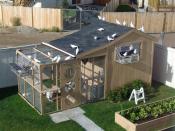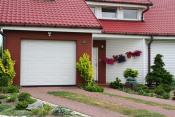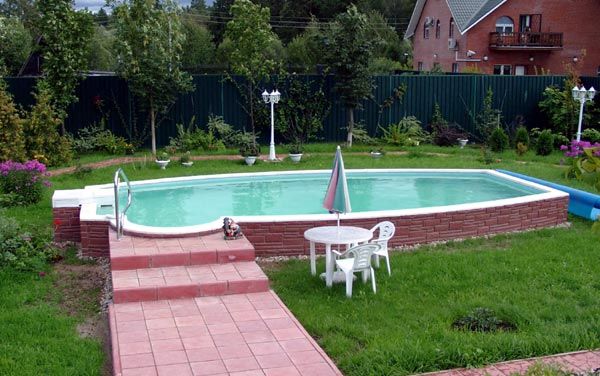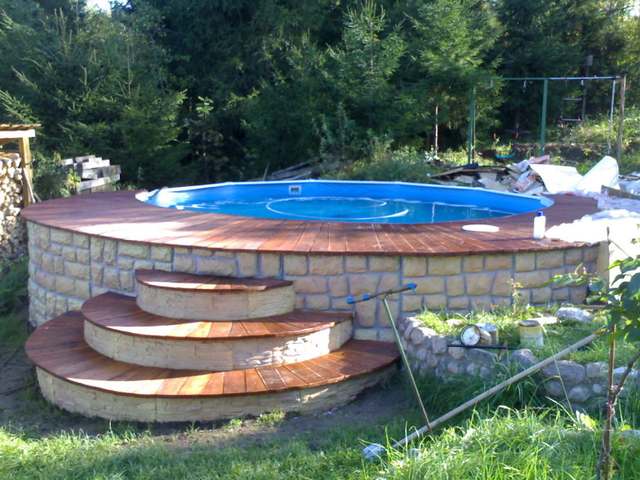Search
Login
Recommended
How to build a do-it-yourself pool
On hot summer days, the pool in the garden is able to give great joy from swimming in it, how much more interesting your garden will look. How happy the children are playing in the water. Solved! We are building a pool ...
Content
- Pool Dimensions
- Build an oval dug pool
- Half-dug pool video
- Ground pool
- What water in the pool is safe for health
- Chemicals for pool water treatment
- Characteristics of chemicals for water treatment in the pool and recommendations for their use
Pool Dimensions
Starting to the question of designing pools, you can turn to specialists http://bassein-ozero.com.ua/pool.html, it should be remembered that the basis for determining the size will always be the size of the human body. These data are taken into account when choosing the depth, width, length of children's pools and pools for an adult. First of all, you need to calculate the size of the pool mirror. For example: for swimming on one lane - the optimal size of the pool is 2.25 meters wide, 5.25 meters long; for swimming on two lanes - 4 meters wide, 5.25 meters long. Next, determine the depth of the pool. The optimal pool depth for adults is considered to be a level of 144 cm.
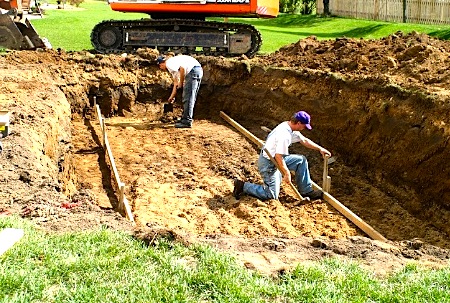
If jumping from a 1 meter high platform is foreseen, for safety reasons, the depth may not be less than 230 centimeters. In any other case, an increase in depth is not economically justified, since there are no benefits, and operating costs increase significantly. For children's pools, the base depth is 50 cm, for older adults - up to 80 centimeters. Of course, you can change the depth from 110 cm to 150 cm, but in the first case this will limit free movement in water, and in the second, operating costs will increase sharply. For example, maintaining a pool with a volume of 50 cubic meters will cost twice as much as a pool with a volume of 40 cubic meters.

Often the question arises of increasing the length of the pool for training mini-swims. After all, you do not have time to push off from the pool wall, when you already reach the opposite wall. There is a special device for this - counterflow. A powerful oncoming water flow simulates a strong oncoming flow, creating ideal conditions for a training swim. But such projects involve a lot of cost. Therefore, another simple and witty solution is proposed; special swimming braces are available for swimming in the pool. They will successfully replace the counterflow and will not require an increase in investment.

The choice of location and the geometry of the pool mirror are important. For location geometry, it is important to know the direction of the prevailing winds. This arrangement will be optimal when the wind blows along the length of the pool. Then all the polluting particles (dry leaves, other light fragments) will be nailed to the opposite end wall of the pool, where a drain device (overflow pipe) should be installed. Please note: near the pool there should not be such trees as broom, willow, poplar, horse chestnut. Their roots, rushing to the pool water will damage the waterproofing layer. Ideally, the terrain is very good if it has a slope. This will reduce the amount of excavation work and make it easier to install a system for draining water from the pool.
Build an oval dug pool
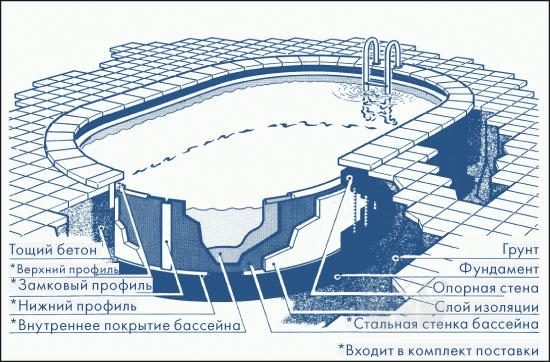
dig a pit
The first and most time-consuming stage of construction is digging a pit. There is an opinion that the rectangle is the best form of the pool, but it is convenient only for swimming, and the design itself is relatively inexpensive.
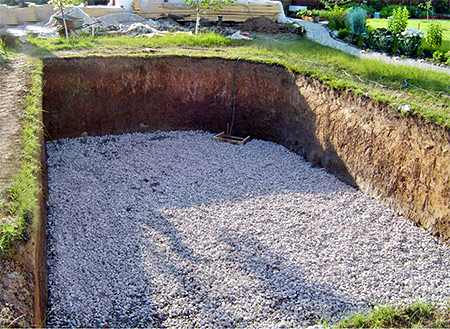
But the pool, created from simple geometric shapes, harmonizes better with buildings and landscape. We will choose an oval shape, when placing the pool you need good sunlight, since the accumulation of insects is inevitable near a pond in the shade. If you are designing a pool near the house, be aware that the distance from the wall of the house to the edge of the pool should be more than half the height of the house.
installation of a pool bowl made of polypropylene
Now we turn directly to the technology of building outdoor pools using a bowl of polypropylene. Such pools are subdivided into dug, half dug, and land. For example, let’s analyze the construction of an oval dug pool. We dig a pit, for this we select the depth of the pool that we want to receive and add 20 cm to this estimated depth, increase the linear dimensions along the length and width of the pool by 50-60 cm.
Why? First - under the bowl you need to prepare the foundation - a pillow. To do this, we prepare the bottom of the pit ideally evenly, we fix over the entire area of \u200b\u200bthe future basin a mesh of reinforcing rods with a diameter of 10-12 mm., Mesh size 150x150 mm. at a height of 10 cm from ground level (for this you can put bricks), then at a height of 20 cm from the ground we set signal beacons. We fill this entire structure with concrete and align it with beacons, it is advisable to fill it in one go. Thus, we made a pillow under the bowl. This foundation should be settled, it is advisable to make a concrete pillow in the fall, and put the bowl in the spring.

After the foundation has stood, prepare the bowl of the pool. For the manufacture of polypropylene bowls, we invite a specialized team engaged in the manufacture of pools. Specialists on the spot will weld a polypropylene bowl according to the given sizes, install it in a pit, bring polypropylene pipes for water, create a closed cycle of water filtration in the pool, for which they will install a filter taking into account the volume of the pool, a water pump, water supply and drain pipes. They can do all the work and completely, but if you want to reduce the cost of your pool, then do all the earthwork and concrete work yourself.
pool side concreting
The second stage in concreting is the filling of a space of 25-30 cm between the ground and the pool wall, which we laid in the dimensions of the foundation pit initially. Before filling the sand-concrete mixture, it is necessary to fix foam sheets with a thickness of 5 cm to the outside of the pool, it will serve as a shock absorber during the natural movement of the pool. We begin to fill the pool portionwise with water, having received a water level of 30 cm., At the same level we fill the sand-concrete mixture (1: 4), fill it up, pour this mixture with water. Then we add water to the pool for another 30 cm, then again we fill the sand-cement mixture to the same level. Thus, in stages, we fill the pool and fill the space between the ground and the pool.
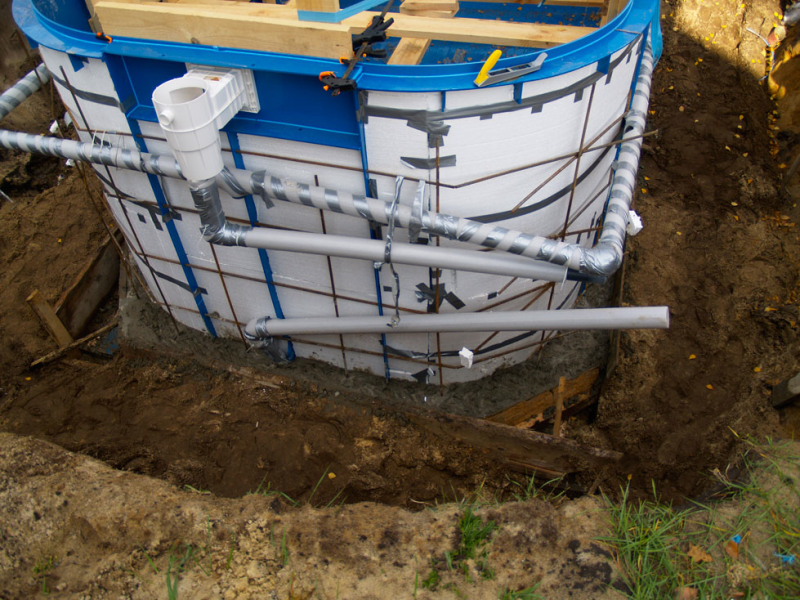
equip the area around the pool
The last stage of work is the final concreting of the upper part of the pool, without forgetting to insert glasses in the upper concrete layer to secure the stairs. When building a pool, use cement grade 500 or higher. At the end of the rough construction work, carry out finishing work.

There are many options, the taste of the owner can be used in the decoration of wood, ceramic tiles, etc., do not forget to blind area around the pool. And then everything is in your hands and your imagination.
Half-dug pool
The construction of a half-dug pool also involves a large amount of construction work. Of course, this volume will be less than the construction of a dug pool, but it all depends on the size and projected depth. The foundation pit also digs for 20 cm of foundation, the width and length of the pit digs with a margin of 25-30 cm. After making the polyurethane bowl and lowering it into the pit, at about ⅔ height (at the discretion of the customer), the gap between the ground and the pool wall is filled as in the previous case, but around the aboveground part a formwork is built around the entire perimeter, from improvised material - wood, iron, etc., and poured with concrete.
Ground pool
The above ground pool has its undeniable advantages.
Firstly, it reduces the cost of its cost and reduces the complexity due to the fact that excluding work on digging a pit.
Secondly, it is solid rocky soil, the possibility of restricting access for young children, the general architectural plan of the house, etc. First of all, a platform is being prepared for such a pool. To do this, the selected area is deepened by 20 cm, the cushion is leveled and poured as previously indicated. Specialists cook a pool of polypropylene according to the specified dimensions, let down all communications, put a filter and a pump. The walls of the pool are externally pulled together by stiffening ribs according to the design calculation.
What water in the pool is safe for health
Water is the main element in the pool. Its cleanliness requires priority attention. The hydrogen pH indicates the acidity and alkalinity of the water; to determine the pH, there are special strips - indicators. If the pH is above 7.8, the skin will be irritated. With an indication of 8.0-8.9, favorable conditions are created for the reproduction of bacteria, since the effect of disinfectants is reduced. Practice and research have shown that the optimal pH should be 7.2-7.4 (no more than 7.6), this water quality eliminates the process of reproduction of microorganisms that enter the water with each new bather.
Foreign studies have shown that each visitor brings up to 30,000 microorganisms into the water of a pool in a 30-minute stay. Effective disinfection allows special installations - filters. The stationary filtering unit (SFU) is most effective, the filtering material in it is quartz sand. SFU is connected to the pool bathroom with plastic pipes. Water is collected in the SFU and returned back to the pool using special plastic elements, water return nozzles.
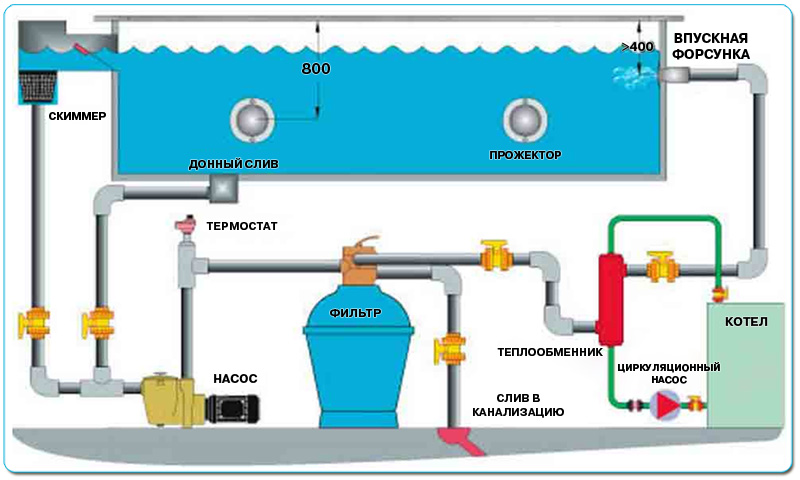
When the pump is running, water comes from the intake device of the upper layer of water (skimmer) and through the pump to the filter tank with quartz sand, where the filtering process takes place. When returning to the pool, water passes through the heater (if any). It is necessary to bring water, electricity, a drain pipe to the place where the SFU is located. To drain water from the pool, you can do only with a skimmer, without a drain pipe, for this, take a flexible hose of a water vacuum cleaner, insert it into the hole of the skimmer, as when cleaning the pool, after sealing the hose and turning on the circulation pump, the handle on the filter should be in the drain position. This method of discharge is used if there is no drain pipe.
Accommodation should be such that SFU is accessible from any direction. When installed outdoors, the supply pipes must be reliably protected from frost and other atmospheric influences. In the cold season, it is necessary to drain the water from the filter tank and the pre-filter tank, for which use the drain valves in the lower part of the respective containers, as well as to free the supply pipes from the water (blow with compressed air). During the winter period, the water from the pool drains at half its height (if there is a spotlight, it must remain above the water level). In the water for the winter you need to throw empty plastic bottles, rubber chambers, or you can throw a few logs.
Chemicals for pool water treatment
Preparations that will be used for water treatment can be divided into seven groups. They are represented
1.Shock chlorine - the rapid formation of active chlorine, the destruction of bacteriological flora, the decomposition of chloramines contained in water.
2. Economical chlorine - chlorine of a long exposure time - to maintain an appropriate concentration of chlorine in water
3. Chlorine balance - protects chlorine from rapid decomposition.
4. Flocculator - precipitates mineral substances contained in water.
5. Stimulator of acid-base balance (KSB) - increases the pH-factor.
6. Reducer of acid-base balance - lowers the pH.
7. Algae eliminator - destroys the algae contained in the water.
In Germany and Sweden, significant results have been achieved in the development of preparations for water purification; a significant assortment of these preparations is also available in our market. Do water treatment in the pool at least once a week. The purpose of this treatment is to maintain a stable acid-base balance of water by disinfection using chlorine-containing preparations. With the help of special test devices, which are widely provided in the trade, constant monitoring of the state of water in the pool is carried out.
The normal acid-base balance is 7.2. In exceptional cases, a balance of up to 7.6 is allowed, if this limit is exceeded, an adjustment of the acid-base balance of the water is necessary, otherwise those who bathe in the pool will feel skin irritation and pain in the eyes. Once a month, plan a general disinfection of pool water. The strengthened rate of use of chlorine-containing substances such as Chlor90 (Germany) will make it possible to destroy the bacteria and microflora in the pool that are difficult to access in the pool. After that, be sure to check the pH.
In addition to chlorine for water purification, inorganic preparations with a 4.5% content of active acidic substances are widely used. Preparations such as ALBAK - 3000 (Germany), disinfect chlorine-free water well during batch processing. With an allergic reaction to chlorine, this drug will disinfect no worse, completely replacing chlorine.
Characteristics of chemicals for water treatment in the pool and recommendations for their use.
|
ALBAK (liquid). |
For the destruction of black and brown algae is used. |
|
Kalkfrei (powder). |
For the removal of calcareous deposits with drained water is used. |
|
Haert - stabilization (liquid). |
To stabilize water hardness. |
|
ALBAK 3000 (liquid). |
General disinfection. |
|
ALBAK 3000 (liquid). |
The fight against bacteria and microflora. |
|
Randreiniger (powder). |
Removing body fat from walls. |
|
Grun (granules). |
Increasing the level of acid-base balance - pH. |
|
Rot (granules). |
Lowering the level of acid-base balance - pH. |
|
Chlor90 tablets in 12 and 20 grams. |
Water disinfection. |
|
Chlor 65. |
Water disinfection. |
|
Chlor 85 tablets. |
Free chlorine decomposition protection. |
|
Chlor - stabilization, powder. |
Water disinfection. |
|
NS Chlor, tablets. |
Water disinfection. |
|
HC Chlor, granules. |
Water disinfection. |
When using water care products in the pool, carefully read the instructions for use.
Brief description of chlorine-containing drugs.
Chlor 90 - Long-acting organic preparation. Contains up to 90% free chlorine, does not precipitate in hard water.
Chlor HC is an inorganic compound. It is calcium hypochloride in tablets (70% free chlorine). It is applied in soft water.
Chlor85 - tablets of long action. Organic compound, free chlorine content up to 85%. It dissolves without sediment, does not affect the acid-base balance (pH-factor).
Chlor65 - Organic compound (granules). Contains up to 65% free chlorine. Does not affect acid-base balance (pH-factor). It is used in hard water.
Chlor - Stadilisator - (chlorine stabilizer). Allows you to slow down the decomposition of chlorine in water under the influence of sunlight and heat. It is added only once a season with organic chlorine.
Chlorine-containing products manufactured in Germany.
Flock - flussig - is used to form a cloudy suspension in water. When used, the suspension is absorbed into the flakes and is easily cleaned with an underwater vacuum cleaner. After applying this product, screen filters are also washed to remove these flakes. The advantage of the drug is that it does not affect the pH.
Kalkfrei - is used to remove limescale deposits from the pool walls, filters with drained water. It is very active, but does not spoil the tiles, plastic cavity and color.
Rand - Reiniger - for cleaning mud (grease) stains on the pool cavity and handrails. After use, the pH level must be monitored.
Haertestabilisator (hardness stabilizer) - used to stabilize the hardness of water, against the formation of mineral plaque, for water of medium and high hardness.
Life does not stand still, so new, more effective drugs for improving the care of your pool appear on the market - these are such manufacturers of pool chemicals as Bayrol (Germany), Astral (Spain), Ocedis (France), Melspring (Holland), Soll and Unipool (Germany), Markopoul - Chemicals (Russia), etc. It remains only to monitor the product market and choose what you like and can afford.
